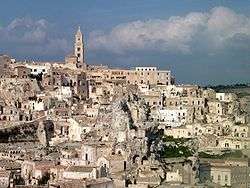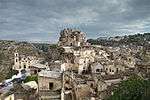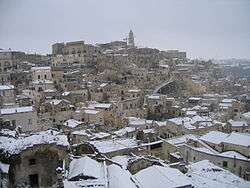Sassi di Matera
| The Sassi and the Park of the Rupestrian Churches of Matera | |
|---|---|
| Name as inscribed on the World Heritage List | |
 | |
| Type | Cultural |
| Criteria | iii, iv, v |
| Reference | 670 |
| UNESCO region | Europe and North America |
| Inscription history | |
| Inscription | 1993 (17th Session) |
The Sassi di Matera ("Stones of Matera" in English) are ancient cave dwellings in the Italian city of Matera, Basilicata. Situated in the old town, they are composed of the Sasso Caveoso and the later Sasso Barisano.
Geography
The "Sassi" grew in the area of Murgia Plateau,[1] extended between Apulia and Basilicata. Along with the "Civita" and the "Piano", the two Sassi form Matera's Old Town.[2]
History

The Sassi originate from a prehistoric troglodyte settlement and are suspected to be among the first human settlements in Italy. There is evidence that people were living here as early as the year 7000 BC.[3]
The Sassi are houses dug into the calcarenitic rock itself, which is characteristic of Basilicata and Apulia, locally called "tufo" although it is not volcanic tuff or tufa. The streets in some parts of the Sassi often run on top of other houses. The ancient town grew up on one slope of the ravine created by a river that is now a small stream. The ravine is known locally as "la Gravina".
In the 1950s, the government of Italy forcefully relocated most of the population of the Sassi to areas of the developing modern city. Riddled with malaria, the unhealthy living conditions were considered an affront to the new Italian Republic of Alcide De Gasperi.[4] However, people continued to live in the Sassi, and according to the English Fodor's guide:
Matera is the only place in the world where people can boast to be still living in the same houses of their ancestors of 9,000 years ago.
Until the late 1980s this was considered an area of poverty, since many of these houses were, and in some cases still are, uninhabitable. Current local administration, however, has become more tourism-oriented, and it has promoted the regeneration of the Sassi with the aid of the European Union, the government, UNESCO, and Hollywood. Today there are many thriving businesses, pubs, and hotels there, as described in an April[5] 2015 New Yorker magazine article.
Photogallery
 Sasso Barisano
Sasso Barisano Sasso Caveoso
Sasso Caveoso- Church of St. Pietro Caveoso
 Panoramic view from the hills
Panoramic view from the hills
Culture

The Sassi are reminiscent of ancient sites in and around Jerusalem, and for this reason they have been used in many Christian-themed films, including The Gospel According to St. Matthew (Pier Paolo Pasolini, 1964), The Passion of the Christ (Mel Gibson, 2004), The Nativity Story (Catherine Hardwicke, 2006) and Ben-Hur (Timur Bekmambetov, 2016).[6]
See also
- Murgia
- Falco naumanni
- Museo-laboratorio della Civiltà Contadina (Museum-workshop of the Peasant Culture)
References
- ↑ Info about the Murgia Plateau
- ↑ http://www.sassitour.it/en/visit-the-sassi-of-matera-with-a-professional-tourist-guide/
- ↑ History of the Sassi
- ↑ Dennis Marks, speaking on the series Appian Way, BBC Radio 3
- ↑ http://www.newyorker.com/magazine/2015/04/27/a-cave-with-a-view
- ↑ "Matera's live nativity draws 30,000". ANSA. 6 January 2015. Retrieved 17 November 2016.
External links
| Wikimedia Commons has media related to Sassi di Matera. |
- Sassi's page on UNESCO website
- Sassi di Matera (HD Webcam)
- Sassi of Matera: what to know and what to visit
- "Life is Beautiful - a travel music video"
- ROBA FORESTIERA, 45 Minutes, Documentary Film on the Sassi di Matera, 2004
Coordinates: 40°40′00″N 16°36′30″E / 40.6667°N 16.6083°E
